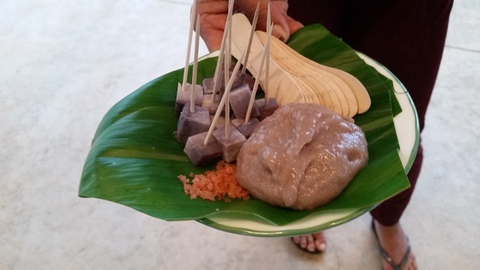To a first-time visitor, Hawai’i looks like a natural paradise, but in reality its lush landscape is often the result of a lot of hard work and much of that is done by volunteers. Spending time in a garden is a great family activity and an opportunity to share a love of nature. Here are some locations that will appreciate your helping hands.

The beautiful bird of paradise flower (Strelitzia Reginae) is a South African import found all over the Hawai’ian Islands. – photo Debra Smith
Budding Gardeners Wanted at the Waipa Foundation, Hanalei, Kauai
How’s your Hawai’ian? Here are a few words that will come in handy when you visit the Waipa Foundation, or any other garden in Hawai’i. Mauka means upland, or the mountainside. The Foundation restores native forests that were clear-cut, used for cattle ranching and taken over by non-native grasses, shrubs and trees in the past. Kula is a wetland or dryland garden. Here’s where students and the community learn how to grow their own organic and sustainable crops. Makai is the coastal zone. Native grasses are being restored around the Halulu fishpond and the Waioli stream that feeds it. More room is being made for native fish by catching Invasive tilapia – and eating them.
Native Hawai’ians divided their land using the natural boundaries of the watersheds that run from the mountain peaks into the sea. These were called ahupua’a. The ahupua’a of Waipa is a 1,600 acre parcel of land where people connect with the ‘aina (land and resources, that which feeds us) and learn about living in balance with the ‘aina through laulima (many hands working together).
Every third Saturday of the month volunteers aged 3 and up are welcome at the Waipa Community Workday from 9 a.m. to noon. Bring your gardening gear (boots, gloves, towel, sunscreen, insect repellant and a water bottle) and your enthusiasm. Volunteers work in most parts of the garden, the taro fields and fishponds. Lunch is provided so please RSVP on their website WaipaFoundation.org. Questions can be directed to their Facebook page.
If you’d rather make a donation while learning more about the farm, take a tour, visit the Tuesday market or make some poi from taro on Thursday nights. For an upscale evening, reserve a spot on a He ’Aina Ola Farm Tour through The Westin Princeville. The Westin supports the foundation’s work through these elegant dining events under the stars. It includes a guided stroll through the orchard and veggie patch and a three-course meal, featuring fresh-from-the- garden menu items, complete with wine pairings.

A traditional Hawai’ian staple, purple poi can be eaten cold or used in baked goods like bread or pancakes. – photo Debra Smith
A Historic Hawai’ian Garden – Kahanu Garden, Maui (The National Tropical Botanical Garden)
At Kahanu Garden you can walk through one of the last pristine native hala forests in Hawai’i and visit the massive place of worship (heiau), built of black lava, called Pi’ilanihale. It’s a National Historic Landmark, believed to be the largest of its kind in Polynesia.
Kahanu Garden also holds the world’s largest collection of breadfruit trees, one of the “canoe plants” that were brought over by the first settlers from Polynesia. Volunteers are welcome to keep this corner of ancient Hawai’i alive by dropping in for as little as 3-4 hours on a one-time shift. “The Gardener Assistant volunteer position is available year-round and is perfect for someone seeking a “hands-on” experience with tropical horticulture”, says Jessica Clabo, Volunteer Program Coordinator for the NTBG.

Every part of the hala tree (Pandanus tectorius) was used by the Hawai’ians including the leaves that were woven into mats and thatched roofs. – photo by Debra Smith
The National Tropical Botanical Garden is made up of five gardens, three are on Kauai, one is in Florida and one is on Maui. Each garden has its own distinct landscape and botanical style, from trim and tidy to wild and windblown, although they all shelter beautiful tropical flowers and trees that have been collected from all over the world.
Call the Kahanu Garden in Hana, Maui, at 808-248-8912 for volunteer opportunities. There’s no cost to participate, but volunteers should be 18 or supervised by a parent (no one under 14 please). Visit http://ntbg.org/donate/volunteer.php for details on volunteering at all the NTBG gardens,
A Dozen Kid-Sized Gardens to explore – Urban Garden Center, Pearl City, Oahu
Have you ever seen a Pizza Garden? Hint: It’s 15 feet wide, shaped like a circle and full of edible plants that can be used as pizza toppings. How about an Animal Garden, or a Butterfly Garden where your little ones can play their way through garden sculpture cocoons and emerge like butterflies? The Urban Garden Center is an extension of the University of Hawai’i and works with the UH Master Gardener Program to delight and educate visitors young and old.
More than half of the 4 ½ acre site is devoted to 12 children’s gardens. Parents will enjoy exploring the fruit tree orchards, inhaling the sweet scent of the plumeria garden and investigating the test plantings. The garden is open from Monday to Friday, 9 a.m. to 2 p.m. Admission is free.
Volunteers can join UH Master Gardeners on weekdays and at the popular Second Saturday in the Garden Program. Call 808-453-6050 to register. Volunteers should be over 18. Visit their website at https://www.ctahr.hawaii.edu/ougc/index.asp for more details.

Volunteering in Hawai’i can take you to some beautiful places. – photo Debra Smith
Take it to the next level – UH Master Gardener Program, Oahu
Why just be a gardener when you can be a Master Gardener, the most highly trained kind of volunteer? There is a huge demand for gardening info from school garden programs, home gardeners, plant industry professionals and students of all ages. It’s a commitment and when you’re done the program is recognized throughout Canada and the USA. Training classes are held every year from January to end of May. They meet at the Urban Garden Center Classroom from 9 a.m. to noon, each Friday for 16 weeks, a perfect schedule for snowbirds with a passion for gardening and volunteering.
For general information on all of the Hawai’ian Islands, visit GoHawaii.com




